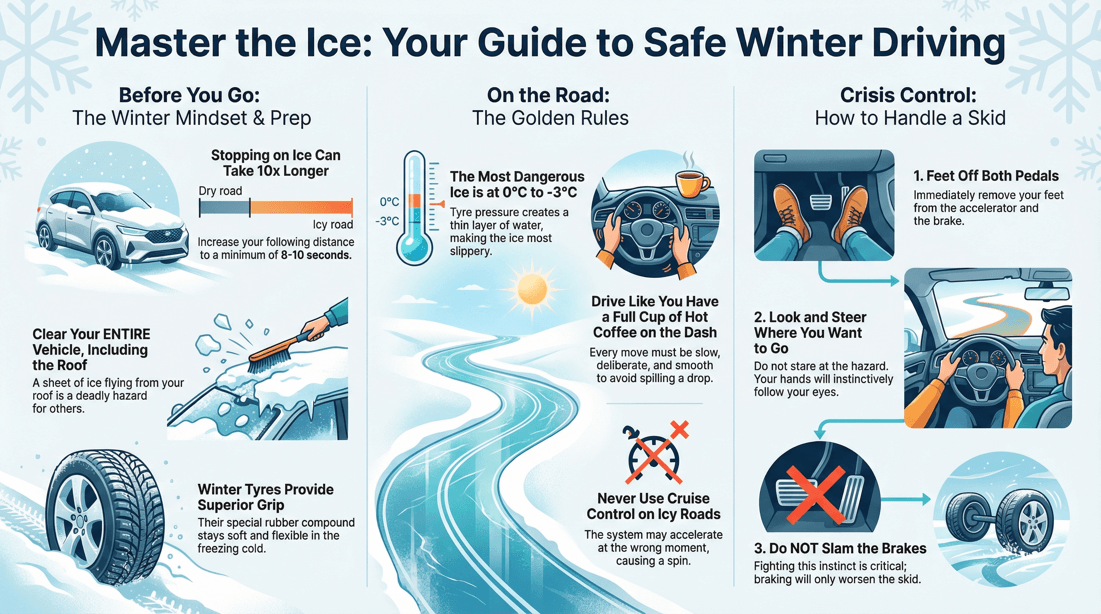
Snow
💡 Tips:
? Questions:


💡 Tips for driving in the snow
Reduce your speed and drive well below the posted limit in snowy conditions. Increase your following distance to at least eight to ten seconds. Accelerate and decelerate slowly to maintain traction and avoid skidding. Avoid sudden movements like sharp turns or hard braking. Use low beams in snowy or low-visibility conditions to improve visibility. Clear snow and ice from all windows, mirrors, lights, and the roof before driving. Use winter tires for better grip and handling on snow and ice. Keep a full tank of gas to prevent fuel line freeze-up and for emergencies. Be especially cautious on bridges, overpasses, and shaded areas that freeze first. If you start to skid, steer in the direction you want the front of the car to go.
? How can you maintain traction when roads are covered in snow?
Drive slowly to reduce the chances of skidding. Accelerate and decelerate gradually to avoid spinning your wheels. Increase your following distance to allow more time to react. Avoid sudden steering movements that can cause a loss of control. Use low gears to improve traction, especially when going uphill. Equip your vehicle with winter tires for better grip in cold and snowy conditions. Avoid using cruise control on slippery surfaces. Brake gently using steady pressure to prevent locking up the wheels. If you start to skid, steer in the direction you want the front of the car to go. Keep your tires properly inflated, as cold weather can lower tire pressure. Clear snow from your vehicle, especially the roof, to prevent it from affecting visibility or others. Avoid stopping on hills whenever possible to reduce the risk of spinning out. Plan your route to avoid steep inclines and roads known to be icy.
? What are the most common mistakes drivers make in snow, and how can you avoid them?
Driving too fast for road conditions increases stopping distance and the chance of losing control. Failing to increase following distance leaves too little room to stop safely. Using cruise control on icy roads reduces control and response time. Making sudden movements with the steering wheel, brakes, or accelerator can cause skidding. Forgetting to clear snow and ice from windows, mirrors, and lights reduces visibility. Driving with worn or improper tires reduces traction in snow and ice. Overcorrecting during a skid often worsens the loss of control. Underestimating the impact of black ice leads to sudden and dangerous slides. Stopping mid-hill or accelerating too aggressively on inclines causes wheel spin or backward sliding. Ignoring weather warnings or not planning ahead increases the likelihood of getting stranded. Not carrying winter emergency supplies can leave you unprepared in a breakdown or delay. Using high-beam headlights in snow reduces visibility due to glare from falling flakes.
? What should you do if your car begins to skid on icy pavement?
Stay calm and do not panic. Take your foot off the accelerator immediately. Avoid slamming on the brakes, which can make the skid worse. Steer gently in the direction you want the front of the car to go. If you drive a rear-wheel-drive vehicle, you may need to countersteer slightly as the vehicle regains traction. For front-wheel-drive cars, ease off steering as traction returns to avoid overcorrection. Do not overcorrect or make sudden movements with the wheel. Focus on a safe path ahead rather than obstacles. If your car has anti-lock brakes (ABS), apply steady pressure to the brake pedal. If you do not have ABS, gently pump the brakes if braking is necessary. Once the vehicle regains traction, continue driving cautiously.
? At what temperature are icy roads most slippery?
Icy roads are most slippery between 0°C and -3°C (32°F and 27°F). This temperature range creates a thin, nearly invisible layer of water over ice. The combination of water and ice reduces tire grip significantly. At these temperatures, ice is more likely to be "black ice," blending in with the road. Slight warming above freezing can cause snow to melt and refreeze into a slick surface. Vehicles may slide more easily when tires fail to grip the partially melted ice. The risk is especially high in shaded areas, bridges, and overpasses. Sudden temperature drops can quickly turn wet roads into icy hazards.
? How should you drive an automatic car in the snow?
Start slowly and gently to avoid spinning the wheels. Use the highest possible gear when moving off, if your car allows manual gear selection. Engage the “snow” or “winter” mode if your vehicle has one. Avoid sudden acceleration, braking, or sharp steering movements. Apply the accelerator gently to prevent wheel spin. Increase your following distance to allow more stopping time. Brake gently and early using steady pressure. Use engine braking by easing off the accelerator rather than relying solely on the brake. Keep both hands on the wheel to maintain control during unexpected slides. Stay in lower gears when descending slopes to help control your speed.
? What should you keep in your car for winter driving emergencies?
A snow shovel to clear snow from around your tires. Ice scraper and snow brush to keep windows and mirrors clear. Jumper cables in case of a dead battery. Flashlight with extra batteries for visibility in the dark. Warm blankets or sleeping bags to retain body heat. Extra winter clothing including hats, gloves, and socks. Non-perishable snacks and bottled water for sustenance. First-aid kit for treating minor injuries. Sand, salt, or kitty litter to help gain tire traction. Cell phone charger or power bank to maintain communication. Reflective warning triangles or road flares to alert other drivers. Tow strap or rope in case you need assistance pulling your vehicle. Multi-tool or basic toolkit for minor repairs. Windshield washer fluid rated for sub-zero temperatures. Emergency whistle or signal device to attract help if needed.